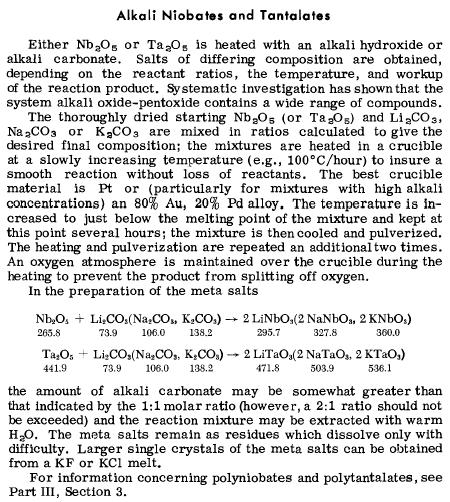bereal511
Hazard to Others
  
Posts: 162
Registered: 9-8-2005
Location: Madison, WI
Member Is Offline
Mood: No Mood
|
|
Sodium Tantalate
I've been looking for information related to the reaction of tantalum metal with sodium hydroxide. It seems that the most predominant product is a
polytantalate ion, but I am simply after NaTaO3. Is there any way to synthesize sodium tantalate aqueously without the formation of polytantalate?
As an adolescent I aspired to lasting fame, I craved factual certainty, and I thirsted for a meaningful vision of human life -- so I became a
scientist. This is like becoming an archbishop so you can meet girls.
-- Matt Cartmill
|
|
|
The_Davster
A pnictogen
      
Posts: 2861
Registered: 18-11-2003
Member Is Offline
Mood: .
|
|
Seems the usual route to compounds of this type would be roasting the tantalum to its oxide, and then fusion with NaOH. Tantalum(and niobium) do not
have much aqueous chemistry that is simple.
I'll dig out the full process tomorrow.
|
|
|
Nicodem
Super Moderator
      
Posts: 4230
Registered: 28-12-2004
Member Is Offline
Mood: No Mood
|
|
| Quote: | Originally posted by bereal511
I've been looking for information related to the reaction of tantalum metal with sodium hydroxide. It seems that the most predominant product is a
polytantalate ion, but I am simply after NaTaO3. Is there any way to synthesize sodium tantalate aqueously without the formation of polytantalate?
|
NaTaO3 is a ceramic and no you can not use aqueous chemistry in its preparation. It can be prepared by calcinating a finely ground stochiometric
mixture of Na2CO3 and Ta2O5 at about 800-1000°C for several hours (I'm not sure about the temperature, but that is approximately a general procedure;
check the literature for details). Then, if the XRD diffraction fits, you can sinter it to whatever form of ceramic part you want it.
Edit: Sorry, I was wrong. NaTaO3 can be prepared by aqueous chemistry though at a slightly harsher conditions:
| Quote: | The starting materials for the synthesis of NaTaO3 were Ta2O5 (AR) and NaOH (AR). In a typical synthesis procedure, 0.60 g NaOH and 0.442 g Ta2O5 were
added into a Teflon-lined autoclave with capacity of 40 ml, and deionized water was added up to 30 ml. The autoclave was sealed and maintained at 120
°C for 12 h without shaking or stirring and allowed to air cooled to room temperature naturally. The crystalline powder product was filtered off,
washed with deionized water and dried in air at 60 °C.
cited from: Synthesis of nanosized NaTaO3 in low temperature and its photocatalytic performance |
[Edited on by Nicodem]
|
|
|
Tsjerk
International Hazard
    
Posts: 3022
Registered: 20-4-2005
Location: Netherlands
Member Is Offline
Mood: Mood
|
|
If the temperature is kept at 120 °C it should be able to be done in a ordinary pressure cooker. Because these usually have a working temperature of
121°C at maximum pressure.
|
|
|
The_Davster
A pnictogen
      
Posts: 2861
Registered: 18-11-2003
Member Is Offline
Mood: .
|
|
Yes, it is carbonate, not hydroxide as I initially said.

|
|
|
bereal511
Hazard to Others
  
Posts: 162
Registered: 9-8-2005
Location: Madison, WI
Member Is Offline
Mood: No Mood
|
|
Can the process work with tantalum metal, possibly in the presence of an oxidizer?
As an adolescent I aspired to lasting fame, I craved factual certainty, and I thirsted for a meaningful vision of human life -- so I became a
scientist. This is like becoming an archbishop so you can meet girls.
-- Matt Cartmill
|
|
|
not_important
International Hazard
    
Posts: 3873
Registered: 21-7-2006
Member Is Offline
Mood: No Mood
|
|
| Quote: | Originally posted by bereal511
Can the process work with tantalum metal, possibly in the presence of an oxidizer? |
According to the attached just NaOH + Ta will react, although air may have been helping.
Attachment: Reaction NaOH with metals.pdf (760kB)
This file has been downloaded 1444 times
|
|
|
Matchheads
Harmless

Posts: 21
Registered: 19-4-2007
Member Is Offline
Mood: No Mood
|
|
Tantalum is like blood diamonds. According to a sign at the zoo, African tantalum mines are causing the extinction of the gorilla. The ore is called
Coltan, as niobium had another name, columbium. There's political pressure on, say, Electrolux, to certify that their tantalum didn't come from these
regions. So, to use it you guys ought to be coming up with a way to replace cell phone capacitors. I just thought you should be told who suffers
when you play with Ta. The zoo society is called CRES, for 'committee for research on endangered species'.
|
|
|
bereal511
Hazard to Others
  
Posts: 162
Registered: 9-8-2005
Location: Madison, WI
Member Is Offline
Mood: No Mood
|
|
The tantalum metal came from old capacitors that had been thrown away. I would be much more concerned with tantalum use by electronic manufacturers
who have made it economically viable rather than humdrum amateur chemists who scrounge for their chemicals.
As an adolescent I aspired to lasting fame, I craved factual certainty, and I thirsted for a meaningful vision of human life -- so I became a
scientist. This is like becoming an archbishop so you can meet girls.
-- Matt Cartmill
|
|
|
not_important
International Hazard
    
Posts: 3873
Registered: 21-7-2006
Member Is Offline
Mood: No Mood
|
|
| Quote: | | About 20% of the tantalum used in the United States comes from recycling. The rest must be imported. Recent major sources for tantalum imports were
Australia, Kazakhstan, Canada, China, Thailand, and others. Australia, Brazil, Canada, Congo (Kinshasa), Ethiopia, and Rwanda are sources of ore.
|
http://www.mii.org/Minerals/phototant.html
|
|
|